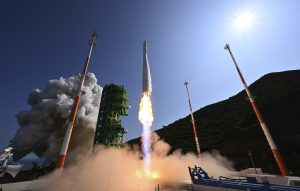The first stage of the Nuri rocket ignited at 4:00 p.m. local time on June 21. As the six satellites in the rocket reached their orbit at an altitude of 430 miles, South Korea became the seventh nation in the world to have successfully launched a greater-than-1-ton payload on a fully indigenous space launch vehicle.
While liftoff to orbit may have taken just 70 minutes, South Korea’s journey to this historic moment involved more than 30 years of painstaking research and development. It is not only an incredible technical achievement by the Korean aerospace industry, but also comes with significant policy implications for South Korea, the region, and the world.
When considering the necessary capabilities for a launch, ranging from propulsion to navigation, the indigenous development of a space vehicle is an excellent indicator of the technical prowess of a nation – or, increasingly frequently, a private corporation. South Korea’s recent achievement in aerospace technologies not only indicates its current maturity as an advanced industrial state, but also promises long-term windfalls for all industrial sectors through continued engagement in its space program.
Unlocking the Low-Earth Orbit (LEO) economy itself is an enormous boon when considering commercial opportunities to expand connectivity and build future-oriented information technology. Simultaneously, research intended for space travel has also been incredibly beneficial even for industries not ostensibly involved in space. In the past, know-how developed for space flight has led to key breakthroughs with commercial application such as CAT scans, GPS navigation, LED lighting, wireless headsets, and more.
It is also impossible to ignore the implications of a successful civilian space program for South Korea’s defense capabilities given Seoul’s difficult geopolitical position. South Korea has not tried to hide the potential military applications for its space program, such as placing domestically produced surveillance satellites over North Korea. Of course, there are obvious associations with the much-discussed arms race on the Korean Peninsula. With the lifting of range limits on South Korean ballistic missiles in 2021, and other developments in indigenous surface-to-air missiles and SLBMs, the military ramifications for the development of precision-guided, long-range, rocket-propelled vehicles are clear.
But beyond the Korean Peninsula, South Korea will play a bigger role in helping determine what our collective future in space will look like. The lack of standards and norms of state conduct in space, coupled with the growth of new actors in the sector, has opened the door to new concerns on cooperation and competition. Space has long been a forum for cooperation between competitors, such as the Apollo-Soyuz and Shuttle-Mir programs at the height of the Cold War. However, geopolitical tensions here on Earth have spilled into space in recent years: Russia’s Roscosmos suspended its partnership in the International Space Station (ISS) following Moscow’s invasion of Ukraine, and China has continued favoring the development of its own Tiangong space station.
At this pivotal juncture, South Korea’s active membership in the community of spacefaring nations will give the country an elevated role in shaping the norms of conduct in space. South Korea is party to four U.N. space treaties, and was an early signatory to the U.S.-led Artemis Accords. Seoul’s continued cooperation with the United States and compliance with international norms in space can play a significant role in developing the rules for the “final frontier.”
However, there are complications for South Korea’s space program. President Yoon Suk Yeol has pledged that his administration will systematically support the country’s aerospace ambitions, including the potential establishment of a South Korean aerospace agency akin to NASA in the United States. But a 2018 survey revealed that young respondents in their 20s were the largest demographic with “no interest at all” in space issues. Furthermore, respondents under the age of 30 were more averse to describing government-driven space development as necessary than their older counterparts.
For an administration that drew vital support from this younger demographic, the Yoon government will need to convince this constituency that the $1.5 billion Nuri program and further billions’ worth of decades-long investment into the Korean aerospace industry represent a worthy and necessary national aspiration. In the meantime, more ambitious plans are already well underway, with South Korea’s first moon mission scheduled for this August. Perhaps further tangible successes of South Korean space programs may bring more support and attention to this important endeavor.

































